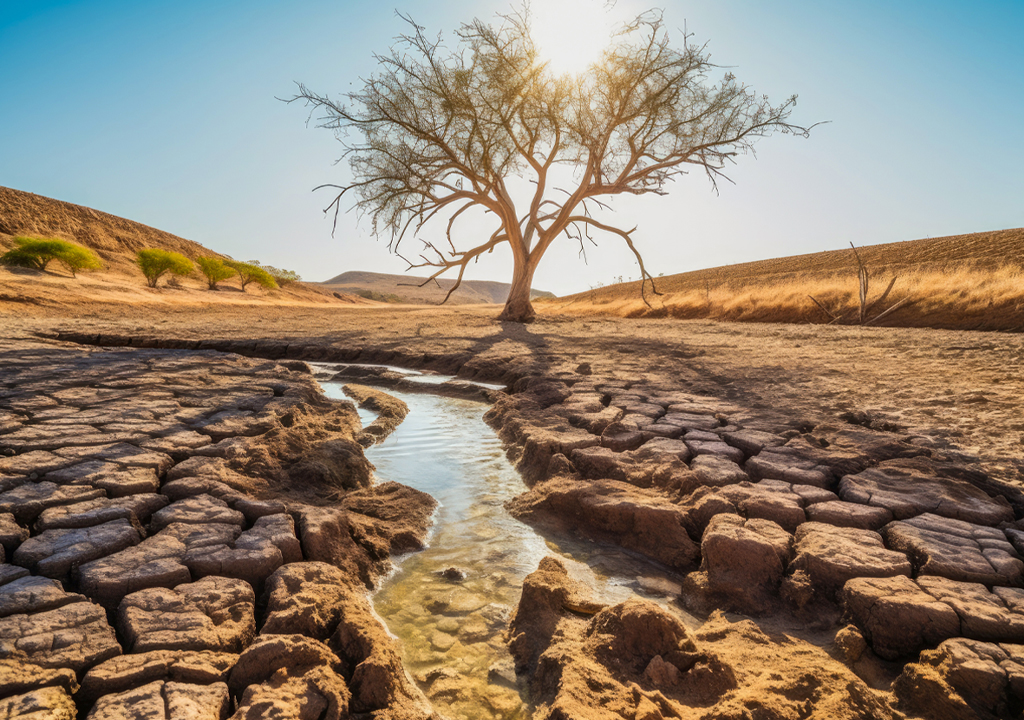Home / Digital Change / Ecological Transition / Water cycle / Water scarcity
Water scarcity
Water scarcity

Water, a fundamental resource for the ecological transition
The surface of our planet is 70% covered by water, but only 2,5% of this is freshwater. Excluding glaciers at the poles, less than 1% remains, of which only 0,1% is destined for human consumption.
Water availability is now being affected by ongoing climate change, which is altering the ecological structure of our planet, affecting both "primary" climatic factors, such as temperature and humidity, and “secondary” factors, such as evaporation.
Most-at-risk Countries
Italy, with a decline of about 38% as compared to the previous year, is the European Country most affected by water shortages in 2022, followed by France and Spain.
In fact, in our Country, between 2000 and 2022, damages due to water scarcity have been estimated at about €20 billion.
Water scarcity also threatens to hinder and undermine the energy transition process: some low-emission technologies, such as biofuels, hydrogen, and carbon capture, have high water requirements, which, if not met, could hold back the achievement of climate neutrality. Additionally, some raw materials that are strategic to the development of green technologies require large amounts of water during the exploration, extraction, initial processing, and transportation phases.
Most critical sectors
In addition to altering the flow of water ways, the shortage of so-called “blue gold”, or water, has a profound affect on various sectors, from agriculture to energy to industry, with significant economic and social repercussions.
According to experts, in order to meet the requirements necessary for these different uses (civil, irrigation, power generation, industrial), the demand for water will double or triple by the year 2050.
At the European level, it is estimated that the economic loss associated with drought amounts to approximately €9 billion per year: the agricultural sector is the most affected, with losses between 39% and 60%, followed by the energy sector (between 22% and 48%).
The increasing water scarcity poses serious risks to the security of the system, as water is an essential input for both electricity generation, fossil fuel and biofuel production, and the transition process, which requires the development of low-carbon-emission technologies with high water consumption.
Digitalization to manage water availability
To ensure water security, it is necessary to optimally reorganize the water storage system and upgrade the infrastructure by utilizing new IT technologies and digitalization for the analysis, processing, modeling, and management of sector-specific information, as well as maintenance and modernization efforts, which would improve the capacity and flexibility of the facilities, ensuring good yields even under conditions of reduced water availability.
.
Almaviva against water scarsity
Almaviva proposal for water scarcity management consists of a data-driven digital ecosystem that leverages the availability of vast public information resources (such as ARPA, ISTAT, Paying Agencies, etc.) to provide the necessary knowledge for managing water availability and its uses. This is achieved through the integrated use of information (pedological, hydrological, agronomic, livestock and crop consistency, weather data, etc.) processed by specific models and algorithms in order to determine the requirements (civil, livestock, agricultural, and industrial) and overall availability.
Almaviva solution for water scarcity provides support functionalities for determining areas in which to build new reservoirs, the use of unconventional resources (such as wastewater reuse), and the monitoring of unauthorized water withdrawals.
Almaviva solution for water scarcity management is based on the following components
Integrated regional data platform
starting from elementary data
Models to determine water
overall availability at a local level
Models to determine potential use
for drinking water, livestock, agricultural, and industrial sectors
An ecosystem to support water demand
Through the integrated regional data platform, Almaviva’s digital information ecosystem for water scarcity management makes it possible to determine water needs and uses by employing specific estimation models, which represent the output of the information component and provide a set of elements for the overall assessment of potential demand at the local level.
By analyzing satellite imagery from the open source Copernicus constellation, it is also possible to determine soil moisture in certain areas and consequently identify any unauthorized irrigation practices. This helps protect agricultural production and ensure fair distribution of available water resources.
The reconnaissance and geo-referencing of all the sewage treatment plants in an area, along with estimation of the outgoing water flow rate, make it possible to direct wastewater to the nearest consortia, thus optimizing the hydraulic structures necessary, also based on local water requirements, while a series of specific sensors continuously monitor the water so as to constantly determine its quality and, in the event of anomalies, send push notifications to those responsible for inspection.


